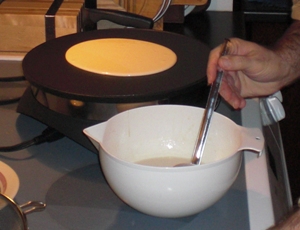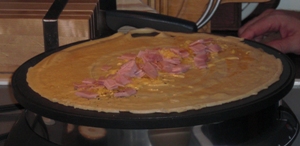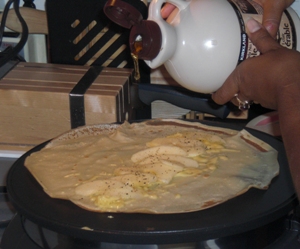Recipe feeds 6 normal people or 4 very hungry people
“Pino” (ground beef filling)
Ingredients:
- 500 grams ground beef (low fat is best)
- 3 onions (see note 1)
- 3 cloves of garlic
- A little bit of cooking oil
- Salt and cumin to taste
- Raisins, soaked in hot water
- Olives
- 2 hard-boiled eggs, divide each egg into 4 segments
- 6 small pieces of chicken
Preparation:
- Chop onion and garlic finely.
- Heat a little oil in a frying pan; add the onion and garlic and fry for a few minutes.
- Add the ground beef to the frying pan and cook over low heat until the meat is no longer red. Stir regularly.
- Add salt and cumin to taste. (see Note 2)
- Put the prepared “pino” in an oven proof dish.
- Boil the chicken in water with salt and some herbs such as bay leaves or other herbs you have on hand.
- In your mind, divide the ovenproof dish into desired portions sizes (for instance six if you have six portions for chicken – but you can make each portion smaller or larger as you wish) and within the (imagined boundaries of each) portion place a piece of chicken together with a piece of egg, an olive and some raisins.
- Next – prepare the corn paste.
———
Corn Paste Topping
Ingredients:
- 6 fresh ears of corn or 2 cans of corn (see note 3)
- Several leaves of fresh basil (see note 4)
- Sugar
Preparation:
- Remember to pre-heat the oven to 200 °C (see note 5)
- If using fresh corn, carefully cut the corn from the cob.
- If using cans of corn and the can has a lot of liquid in it, let it drain.
- Put the corn and the basil in a blender and puree the mix.
- If you used fresh corn, you need to put the corn and basil mix in a pan and let it simmer on low heat for a few minutes. You can skip this step if you use canned corn as that corn has already been cooked.
- Place the corn paste on top of the “pino“, chicken, olives, egg and raisins that you previously placed in the ovenproof dish.
- Spread the corn paste evenly to make a pretty cover for the dish. Sprinkle with some sugar to help give it a prettier color after baking.
- Put the dish in the oven and cook till the corn starts to brown on the top and around the edges. Remember that all ingredients have already been fully cooked, so you are really just warming it up and making the flavors mix together.
Notes and Comments:
Note 1 – I am not a fan of a lot of onion so I use about one onion and lots of green onions (spring onions) instead as they have a gentler flavor, but this depends on your own preferences.
Note 2 – Sometimes I also add paprika powder to give the “pino” a nicer color.
Note 3 – The recipe calls for 2 cans of corn. The cans in Chile are much larger than in Norway and I would recommend using at least 4 Norwegian sized cans. I love the corn paste topping so the truth is I usually use even more corn than that, but once you try the recipe you will figure out how much corn you prefer to use. There should be enough corn paste to at least cover the “pino”, chicken, eggs etc…
Note 4 – The taste will be best if you can use fresh basil for this recipe, but I know that may be hard to find in Norway so then you can use the dry basil (basilikum) that they sell in the herb and spice section of the supermarket.
Note 5 – The oven temperature may vary depending on the oven. It should be quite high, but if it starts burning, try a lower temperature such as 180 °C.
General comments: If you do not like the raisins or olives, these can be left out. You can also reduce the amount of garlic if your guests do not care much for garlic. Also, the Chileans will normally have pieces of chicken in this dish but this can also be left out if you prefer a simpler version. The Chilean food is generally not spicy, but if you want to add some “kick” to the dish you can definitely add a little chili powder, but not too much because it would overpower the sweet flavor of the corn.
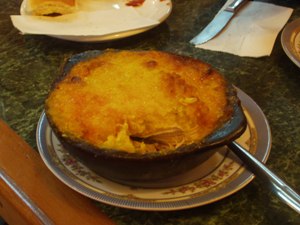
We hadn’t planned to make a Norwegian Christmas dish this year but then, after a chat with both Adelheid and Kristin, we changed our mind. We ran to the butcher down the street to see what he could do for us in terms of salted and smoked meat. While we secretly hoped for lamb, we struck out and came out with a partial leg of pork (as expected).
Ingredients (4-6 people):
-
600 grams salted and smoked ham on the bone (should have been lamb, but such is life)
-
2.5 litres of water
-
600 grams rutabaga peeled and cut into slices about 1cm thick (yellow turnip)
-
1 litre skim milk
-
7 tablespoons of plain flour
-
However many lefse (soft tortillas) you plan to eat
-
Optional depending on taste: one Knorr stock cube any flavour
-
Optional depending on taste: 1 tsp salt
-
Optional: However many of boiled potatoes you plan to eat
Directions:
Boil water in kettle and transfer to pan. Put ham (or lamb) in the water and boil for 2.5 hours. When ca. 40 minutes remain, add the sliced rutabaga to the pan. When the rutabaga is cooked, remove the meat and the rutabaga and keep them warm until serving. Mix the flour into the cold milk and add to the pan. Boil the soup for about 10 minutes longer. Add stock cube and/or salt to taste.
Serve hot soup in a bowl and - if you are not uncouth - meat, rutabaga, lefse, and potatoes on a side plate. Rob and Hild have no couth and therefore add everything to the soup bowl and even dip their lefse in the soup! Honestly, how bad can they get?!
Photo: The meat boiling in the pan
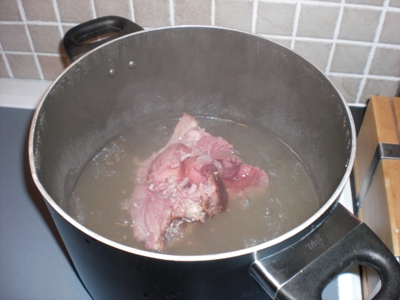
Photo: The sliced rutabaga added to the pan
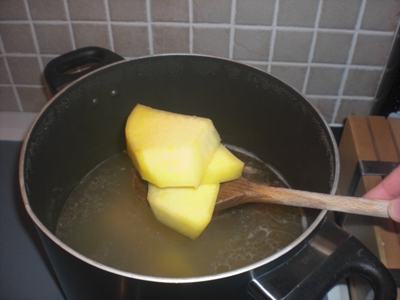
Photo: The milk has been added - nepespa nearly ready
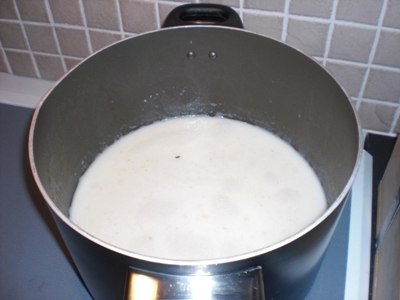
Photo: Dinner is ready!
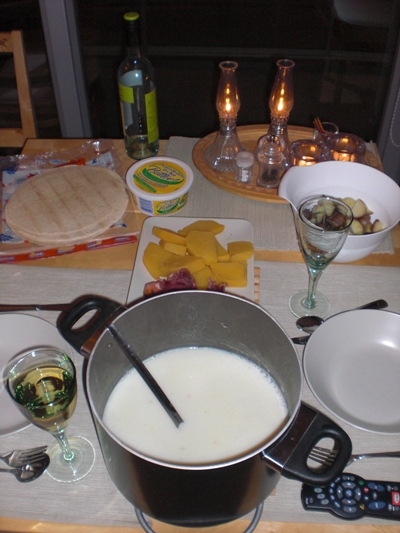
Posted by: Hild @ 6:03 pm
Initially our plan was to make calzone pizza, but then we remembered last time we made those. We made way too big calzones and ate them all…. piglets. So here is an option for a smaller dinner - maybe…
Ingredients (see also ‘Skulebrød’ - http://namnam.rygnestad.net/?p=28)
Dough for 6 horns:
- 20 grams butter (could also use 1/4 dl oil)
- 2.5 dl water (could also be milk)
- 1 rounded teaspoon dry yeast
- 1/2 teaspoon salt
- 1 teaspoon sugar
- ca. 6-7 dl of plain flour
- A little bit of milk for brushing
We like to not fill 2 horns and keep them for “afters” so - Filling for 4 horns (use whatever you’d like):
- 1/2 canned ham = 225 grams - chopped
- 3 rings of pineapple - drained well
- 1/4 red pepper - chopped
- 1/4 yellow pepper - chopped
- 12 table spoons cottage cheese (3 per horn) - drained well
Directions:
Follow the directions from ‘Skulebrød’ until the dough has risen once to approximately twice its original size. Divide the dough in two halves and roll it out. Cut three triangles from each half. Put some ham, pineapple, pepper, and cottage cheese at the wide end of each triangle. Fold the corners of each triangle around the filling and roll it up toward the pointy end of the triangle. [I know that this is cryptic - but the end result should look like a horn…]
Put the horns on a baking tray covered in aluminium foil and/or sprayed with oil. Cover the horns with a tea-towel and leave them to rise another 10-15 minutes. Turn on the oven and set it to 225 celsius. Bake the horns for 20-25 minutes in the middle of the oven.
Before serving, leave the horns on a rack to cool down. We ate them too soon and burned our mouths.
[This is where I would have added before- and after-photos, but the shutter speed on our camera is no match for Rob’s hunger. The horns were all gone before I could get a photo…. see: here is the empty plate!!]
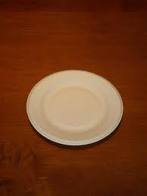
Most evenings when we realise that it is dinner time we just make sandwiches, something we’ve been told is very boring. This is true, so last week we were inspired to explore the fridge and see what needed eating and whether they added up to a meal. We ended up with a quiche - a standard way of eating left-overs!
Pastry:
-
4 oz plain flour
-
1 oz lard
-
1 oz butter
-
a little bit of salt
-
cold water to mix (4-5 tablespoons)
Preheat oven to 180 Celsius. Mix all ingredients and knead the dough enough for it to be rolled out (not any longer). Roll the pastry thin enough to line the quiche dish (ours was 19cm in diametre). Bake it in the oven for 20 minutes
Filling (approximate as it was whatever we had left in the fridge!):
-
400 gr spinach
-
Some butter
-
1 dl ricotta cheese
-
1 dl sour cream
-
2 beaten eggs
-
salt + pepper + 1/2 grated nutmeg [thanks to Rob for reminding me about this in his comment]
Cook the spinach in the butter. Add the remaining ingredients and cook for a while longer. Add the filling to the baked pastry. Bake quiche for another 10 minutes.
Topping:
-
1 apple (sweet rather than tart)
-
1 dl grated Swiss cheese
-
some grated parmesan
Peel and slice the apple into thin slithers. Cover the quiche in apples and grated cheese. Bake quiche for another 10 minutes or until the cheese is light brown.
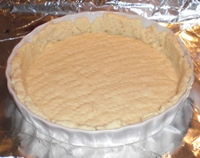
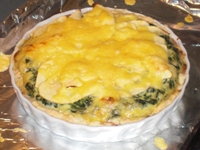
Posted by: Hild @ 6:53 pm
After a mini-holiday skiing in Mont-Tremblant, Quebec, we were inspired to buy a crepe maker. We were inspired after having two meals at Crêperie Catherine - dinner one day and returning the next day for dessert. We had front-row seats to see how the crepes were made in their little kitchen. To a Norwegian, a crepe maker is simply a small “takke” on which we make lefse (see recipe for hardangerlefse). We also predict many other uses for a crepe maker including making quesadillas or simply warming up tortillas filled with all sorts of goodness. That would be more interesting than sandwiches, for sure!
Crepe ingredients - Alternative 1 (UK/Delia crepes):
-
6 oz plain flour
-
a pinch of salt
-
2 large eggs
-
7 fl oz low-fat milk
-
3 fl oz water
Crepe ingredients - Alternative 2 (crepe recipe - came witht he crepe maker):
-
2 1/4 cup flour
-
1 teaspoon salt
-
(1 tablespoon sugar)
-
1 egg
-
1 cup water
-
1 1/3 cup low-fat milk
Crepe ingredients - Alternative 3 (Norwegian pannekaker):
-
ca. 3.5 dl flour
-
2 eggs
-
6 dl low-fat milk
-
1 teaspoon salt
-
(1-2 teaspoons sugar)
-
(1 tablespoon margarine or butter)
Mix the eggs, milk and water gradually to the flour and salt.
Avoid getting a lumpy batter. If you are unlucky (like we frequently are), simply strain the batter before cooking the crepes. Heat up the crepe maker (our brand needs mark 4-5). Put sufficient amount of batter to the middle of the crepe maker and use a crepe-scraper to spread the batter in a smooth and circular motion. We are still applying the trial-and-error method to determine how much batter and how to spread it evenly…. simply eat the errors. Cook the crepe 10-15 seconds on each side. Flip the crepe back to the first side and add filling as you like.
Some of the crepe fillings that we’ve tried:
-
Sliced/chopped ham, grated swiss cheese, a dash of maple syrup, freshly grated pepper
-
Peeled/sliced sweet apples, thinly sliced brie, a dash of maple syrup, freshly grated pepper
-
1 beaten egg, sliced/chopped ham, grated cheese
-
Ricotta cheese, handful of fresh baby spinach, freshly grated pepper
-
Ricotta cheese, peeled/sliced sweet apples, a dash of maple syrup (this one got a bit too soggy!)
-
Italian meatballs, fresh mozzarella cheese, tomato sauce (e.g. Prego)
-
Slices of steamed salmon, peas, sweet corn, tzatziki sauce
-
We haven’t tried sweet ones yet, but we’re picturing chocolate sauce, bananas, berries, manchar…. nam nam
We prefer to put the filling in the middle of the crepe and fold in the sides twice to make an envelope. This crepe-envelope can be flipped over and cooked/heated on both sides. For easy taste testing with family and friends we have loaded the filling down the middle of the crepe and folded over once to slice it up in several pieces.
I’m sure we’ll think of more ways of doing this as just about everything we eat now ‘goes’ past the crepe maker!!!
Some photos: (1) Rob adding batter to the crepe maker. (2) Ham and cheese filling. (3) Apple, brie and maple syrup
